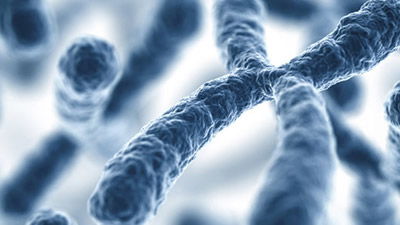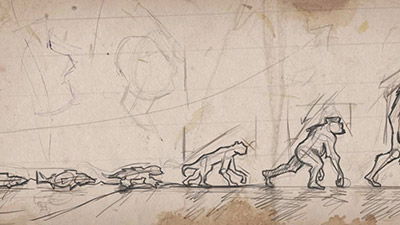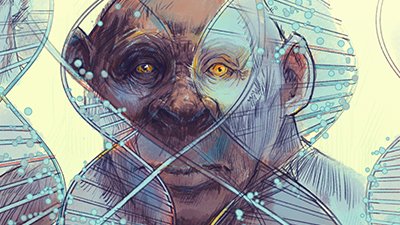Are There Transhumans in Our Future?
Introduction
Transhumanism is the belief or theory that the human race can evolve beyond its current physical and mental limitations, especially by means of science and technology, to become “superhumans” of sorts. Science fiction addresses this topic quite often, as evidenced by frustrated cries of “Khan” (a “successful,” but evil eugenics experimental human) in Star Trek, while the X-Men movies portray many “mutants” as higher-evolved humans with special superhuman/superhero skills in a positive light (along with some formidable supervillains). But is there any reason to fear—or perhaps even be encouraged by—advances in humankind?
Clarifying Terms
We’ve already defined transhumanism above, but let’s clarify what the terms evolution, science, and technology indicate in that definition. Evolution can mean change—typically uphill. Is man changing? We see such things as the near eradication of some diseases, certainly, but is he evolving in a molecules-to-maniacal monster (such as Khan) sort of way? While technology, the application of already-acquired knowledge for practical purposes by men, is improving and prolonging man’s quality and length of life, it is not a biological change, nor does it produce one. Science, defined as the intellectual and practical activity encompassing the systematic study of the structure and behavior of the physical and natural world through observation and experiment, produces nothing new biologically. Note that the common denominator is the agent of man, not some mystical “improvement ratio” beyond our affect. Man’s ingenuity is the impetus for both science and technology, and it is in his best interest to improve his own status. But man works with what is already there, often merely “stand[ing] on the shoulders of giants” as Jurassic Park’s Michael Crichton, via the book’s consultant mathematician Dr. Ian Malcolm, put it.
Eugenics, the method many envision as producing a super race via controlled breeding to increase the occurrence of desirable heritable characteristics, is a clear-cut example of artificial selection of what is already there, whether one finds that principle detestable or not because of its rather jaded past. Bionics, on the other hand (pun intended), is using technology in the form of biomimicry (typically used now to replace—often to a lesser extent—a lost function in man). A good example of this is AiG’s Dr. Georgia Purdom, who has a bionic ear because of a defect in her inner ear. If the technology continues to improve, it is possible it could become superhuman in the extent of its potential and use—perhaps able to pick up cell phone conversations around her—but this does not make her superhuman. Even something like a bionic hand that can crush things a normal human hand can’t, is impervious to pain, and so on, only imbues the individual with the “superhuman” ability when worn. There is no change to the person that is heritable. This technology is fascinating and can be beneficial to humankind, but it is intelligent design with man copying God’s design, not evolution.
Only staunch belief in chemicals-to-chemists evolution (despite its being unobservable and unrepeatable) provides any reason to believe that man, via normal biological mechanisms, will eventually amount to anything more than a 46-chromosome1 sentient being that ponders such things. In fact, it demands it—unless of course we somehow hamper or extinguish ourselves from the universe by using said advanced technology irresponsibly (a recurring theme in sci-fi films that dabble in transhumanism).
History of Transhumanism
If man is the only “demonstrable” agent for our uphill progress, should we be patting ourselves on the back? Well, that depends on what your definition of uphill is, and whether you believe the Bible. Genesis 1 gives us a hint: we are shown how God, in cooperative effort with Himself, created mankind “in His own image,” blessed and said to them (Adam and Eve), “have dominion . . . over every living thing,” and called His creation that day “very good.” Hold off on that pat, though. In Genesis 3, Adam and Eve try to devise their own form of transhumanism via the tree of knowledge of good and evil, resulting in loss of everything for them and us. From that point forward, ironically, it’s been downhill for mankind. Humans were at their biological pinnacle the second before they attempted to reach beyond, and it was that very effort that doomed us to never attain it again. One need only scan the next few pages in the book of Genesis to see how far downhill “the Fall” really was on man’s body and spirit: murder, greed, declining lifespans, infertility, disease, suffering.
Recent technological advances, primarily in medicine, have relieved some of this, but we still die. We may have cell phones that can call halfway around the world, but do we have beneficial communication with other cultures? Many have food, but do we have health, substance, and satisfaction? There have been eugenic and ethnic cleansing campaigns, but, apart from perhaps a greater average height, particularly in affluent cultures2 or other esoteric and reversible trends, man remains unchanged if one only takes recorded history and archaeology into account—not the imaginations of evolution-inspired millennia-past comprised of ape-men and amoebae. As geographic and cultural barriers break down due to man’s ingenuity in travel, we receive both the benefits and the detriments of constant shuffle in man’s global gene pool, confirming that mankind is of “one blood” (Acts 17:26). But man’s situation is as desperate as it was the day Adam and Eve tasted the fruit—if we are to take only man into account.
But Scripture also discusses a Man who truly was superhuman. Among them, John 1 eloquently describes who this Man is; Luke 1 describes the miraculous way He got here; John 18:37 explains why He came; Matthew 17 describes a transfiguration that exposes some of His deity in human form; and John 20 describes Him in a resurrected body. Many other passages throughout the Gospels of Matthew, Mark, Luke, and John describe His miraculous feats and mesmerizing intellect. Even in His death, the soldier standing by realized He must have been the Son of God (Matthew 27:54).
Brave New Earth
We can be thankful that we still retain the image of God, though imperfectly, as instilled in our first physical ancestor Adam some 6,000 years ago. This gives us the means for discovery and creativity, easing the burden we put on our own backs. With that God-given intelligence, we should pursue easing the suffering around us with some of these “transhuman” technologies and other advances in medicine and technology, but Christians know who deserves the credit for this mercy and grace in light of man’s fallen state, and it is not time, chance, and mutations! But as even science-fiction books such as Jurassic Park and Brave New World warn us, we must use those skills and resources in a responsible way. Unchecked and immoral use of technology will no doubt lead to horrific abuse of the gifts we’ve been entrusted with, as has already been seen with, for example, animal-human hybrid embryos3 and embryonic stem cell use.4
In God’s infinite mercy, He has given us the ability and resources to help us along until He is ready to return and restore all things, including His people’s frail human bodies (Revelation 21–22). And He has given us “giants” upon whose shoulders we can stand, many of whom reveled in the evidence they saw for our Creator in their discoveries.
So it seems that we are in a state of “in-between.” Adam and the next few generations would be what we might consider superhuman, having lifespans and likely intellect far surpassing that of any seen today. Jesus Christ, although God incarnate, was the firstfruits of the Resurrection and paved the way for the next “upgraded version” of humanity, as laid out in beautiful detail in 1 Corinthians 15. And although Jesus has returned to heaven for now in His glorified body, He has told us in John 16, “but I will see you again and your heart will rejoice, and your joy no one will take from you.
” I can’t imagine a better future than that.
References
Anissimov, Michael. “Special Report: Top Ten Transhumanist Technologies.” Lifeboat Foundation, accessed May 28, 2015. http://lifeboat.com/ex/transhumanist.technologies.
Dallas, Kelsey. “The Morality of Playing God with Your Baby’s DNA.” Daily American, March 30, 2015. http://www.dailyamerican.com/life/the-morality-of-playing-god-with-your-baby-s-dna/article_a21beff1-5a2a-5d0e-bad0-0749383cc8b8.html.
Ham, Ken. “Are Humans Still Evolving?” Around the World with Ken Ham (blog), March 4, 2015. https://answersingenesis.org/blogs/ken-ham/2015/03/04/are-humans-still-evolving/.
Smith, Calvin. “Transhumanism—Mankind’s Next Step Forward?” Creation Ministries International, February 3, 2011. http://creation.com/transhumanism-mankinds-next-step-forward.
Footnotes
- Acknowledging that because of man’s rebellion against God in the Garden of Eden, the world now includes examples of genetic variance, like trisomy, that, sadly, always result in at least some physical impairment to those individuals—the opposite of uphill evolution.
- “Why Are We Getting Taller as a Species?,” Scientific American, June 29, 1998, http://www.scientificamerican.com/article/why-are-we-getting-taller/.
- Callie Joubert, “Chimeras, Cybrids, and Hybrids: A Christian’s Observations and Critique of Some Aspects of the Controversy Involving the Mixing of Human and Animal Materials for Scientific Research,” Answers Research Journal 6 (2013): 321–333, https://answersingenesis.org/morality/chimeras-cybrids-and-hybrids/.
- Elizabeth Mitchell, “Human Clones: Created to Die,” Answers in Genesis, May 30, 2013, https://answersingenesis.org/sanctity-of-life/cloning/human-clones-created-to-die/.

Answers in Genesis is an apologetics ministry, dedicated to helping Christians defend their faith and proclaim the good news of Jesus Christ.
- Customer Service 800.778.3390
- Available Monday–Friday | 9 AM–5 PM ET
- © 2025 Answers in Genesis




